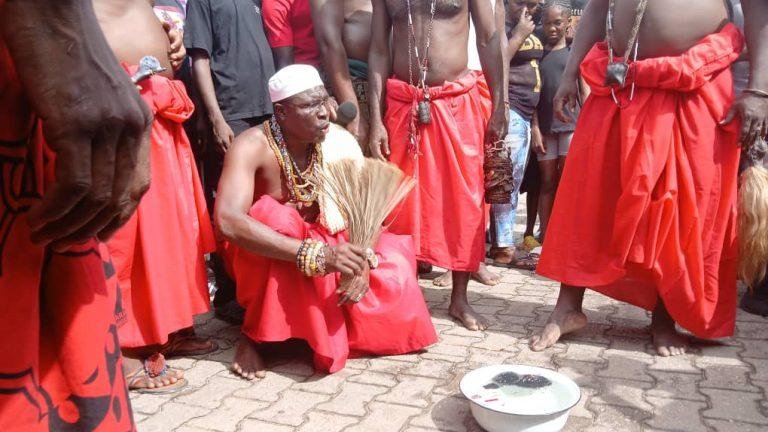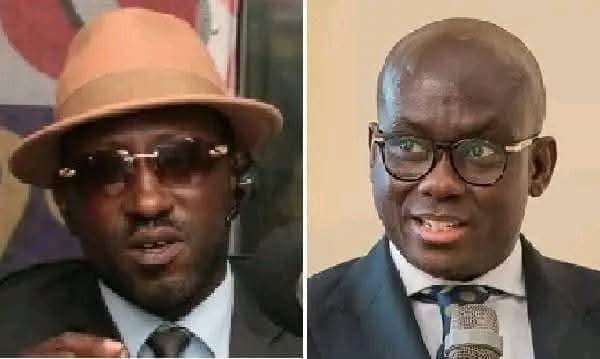News
Rich African culture, tradition on display at Asantehemaa funeral rites

The rain began at precisely 4:25 p.m. on Tuesday, September 16, 2025, the second day of the funeral rites of the late Asantehemaa, Nana Konadu Yiadom III.
In most places, such a downpour might have sent mourners scurrying for shelter, umbrellas snapping open like protective wings. But this was Manhyia Palace in Kumasi, and this was no ordinary farewell.
As thousands stood steadfast in the rain, their traditional black ‘Kuntunkuri’ garments darkening with moisture, something magical was about to unfold.
The Asantehene, Otumfuo Osei Tutu II, seated regally in his palanquin and surrounded by loyal chiefs, was being carried across the funeral grounds to greet his people who had come to honour his late sister, Nana Konadu Yiadom III.
Then came the moment. The bearers stopped at a point. The drums spoke their ancient language. And in a gesture that perfectly captured the soul of a kingdom, the king of the Asante people appeared ‘possessed’ in the palanquin and danced—gracefully, purposefully, powerfully—in the rain.

The crowd erupted. Cheers thundered across the palace grounds, mixing with the rhythm of traditional drums and the percussion of raindrops on umbrellas and rooftops.
Nana Konadu Yiadom III was no ordinary royal. Born in 1927 at the sacred Benyaade Shrine at Merdan, Kwadaso, Nana Ama Konadu was the daughter of Nana Afia Kobi Serwaa Ampem II, Asantehemaa from 1977 to 2016, and Opanin Kofi Fofie, a respected carpenter from Besease near Atimatim.
She lived for 98 remarkable years, serving as the 14th Asantehemaa—the Queenmother who stood not behind, but beside the king, wielding spiritual authority and political wisdom in equal measure. She ascended the stool on February 6, 2016.
On August 12, 2025, the Asantehene shared that the Queenmother had been remarkably active on the morning of her final day, attending to her duties with characteristic vigor before her sudden departure in the afternoon.
Her passing came just a day after the nation was plunged into mourning following a tragic military helicopter crash that claimed the lives of eight high-ranking government officials.
Her eight-year reign was marked by what those who knew her described as ‘quiet strength’ and ‘institutional wisdom.’
As elder sister to the Asantehene and guardian of the Oyoko lineage, she was far more than a ceremonial figure. The Asantehemaa nominates the next king, rules on disputes, and commands her own palace.
She is the keeper of matrilineal succession, the voice of ancestral guidance, and in times of crisis, even a war leader—as history remembers from Yaa Asantewaa’s legendary stand against British colonialism in 1900.
The late queenmother’s passing marked the end of a lineage stretching back to 1695, from Nana Nyarko Kusiamoa to the present day.
Some reigned for decades, like Nana Konadu Yiadom I (41 years) and Nana Afia Kobi Serwaa Ampem II (39 years), while others, like Nana Yaa Dufie and Nana Ama Serwaa I, held the stool for shorter but no less impactful tenures.
Each Queenmother brought her own gifts—some as fierce protectors of tradition, others as reformers and mediators. Together, they form what one historian called “a tapestry of Ashanti womanhood that stretches across centuries.”
Business
But, even in mourning, life finds a way to celebrate culture. Across the Palace, sales of mourning cloths, (Kuntunkuri), amulets, ‘Ahenema’—the traditional royal slippers also known as ‘Kyawkyaw’—have skyrocketed during the funeral rites.
‘Kyawkyaw’ are not mere footwear; they are cultural artefacts dating back to the 18th century, each pair telling a story through its symbols and colours.
The black funeral slippers bear names that sound like poetry: ‘Anibere a nso gya,’ ‘sika wo ataban.’ Each design reflects not just fashion, but identity, status, and occasion.
During the funeral, chiefs and queenmothers could be seen carefully polishing their Ahenema, preparing to honour their departed matriarch in proper traditional style.
Traders told local media that while sales were always steady, the funeral has brought unprecedented demand. “Everyone wants to pay their respects properly,” explained one vendor.
The four-day funeral, running from September 14-18, has transformed Kumasi into a cultural epicentre drawing dignitaries from across Ghana and beyond.
To ensure dignified and orderly participation, the Palace designated specific days for various institutions and groups to pay their respects.
Monday, September 15, was reserved for churches and clergy, political parties, educational institutions, non-governmental organisations, telecommunication firms, corporate bodies, recognised associations, and the general public.
Tuesday, September 16, would welcome the Judiciary and Ghana Bar Association, security services, including the Ghana Armed Forces, Police, Fire Service, Prisons Service, Immigration, and Customs, alongside State-Owned Enterprises, public officers, financial institutions, and the general public.
Wednesday, September 17, was designated for Ministers of State, the Diplomatic Corps, Members of Parliament, Metropolitan, Municipal and District Chief Executives, non-Asante chiefs, mining companies, and the general public.
Spiritualists and traditional groups from across Africa set the tone for day three of the funeral rites of the late Asantehemaa, with striking rituals and cultural displays.
Delegations from Benin and Togo amazed mourners with sacred performances featuring revered deities, offering a rare glimpse into their deep-rooted customs.
The people of Aflao also held the crowd spellbound with a dramatic ritual that saw flames rising from water in a vessel — a symbolic act that stirred awe and excitement among onlookers.
A mourner who witnessed, told The Spectator: “This is not something you see every day. It is a reminder of how African traditions, though varied, can come together under the influence of the Asante Kingdom.”
Speaking to The Spectator a cultural commentator at the event observed, “The Asantehemaa’s funeral is more than mourning. It has become a showcase of Africa’s cultural richness, demonstrating the power of tradition to unify people.”
Thursday, September 18, had the President, John Dramani Mahama, former Presidents and Vice Presidents, the Diplomatic Corps, and the general public.
Other Paramount Chiefs from beyond Ashanti such as Oguaamanhene Osaberima Kwesi Atta II, Paramount Chief of Sefwi-Anhwiaso, Ogyeahoho Yaw Gyebi III, The Ga Mantse, Paramount Chief of Aflao, Torgbi Amenya Fiti V, among others, were all not left out to mourn with the Asantehene.
As the sacred process of selecting the 15th Asantehemaa begins, with the Oyoko clan deliberating under ancestral guidance, one image will remain: their king, dancing in the rain, showing that true majesty is not about staying dry—it is about being present, authentic, and connected to your people, regardless of the weather.
From Kingsley E. Hope
News
Sammy Awuku urges Fourth Estate to follow GJA Code of Ethics when holding duty bearers accountable

The Member of Parliament for Akuapem North, Samuel Awuku, has called on the Fourth Estate to strictly adhere to the Ghana Journalists Association (GJA) Code of Ethics when reporting on public officials and state institutions.
In a statement issued on 25 September 2025, Mr Awuku said a recent publication by the Fourth Estate about the National Lottery Authority’s (NLA) Good Causes Foundation misrepresented facts about projects undertaken during his time as Director-General.
According to him, the article created the impression that funds meant for the underprivileged were diverted to “glamorous events and questionable enterprises” but ignored many life-saving projects, donations and community interventions funded by the Foundation.
He reminded journalists that Article 1 of the GJA Code of Ethics obliges them to provide factual, balanced and accurate information to the public and to cross-check their facts before publication. “For journalists of the Fourth Estate’s calibre who pride themselves in working in the public interest, it is only appropriate that their publications are factual and not misleading,” he stated.
Mr Awuku explained that the NLA Good Causes Foundation was established in October 2021 to rebrand the Authority’s corporate social responsibility arm and focus on health, education, youth and sports development, and arts and culture.
He said that during his tenure the Foundation built 20-seater toilet facilities with mechanised boreholes in several communities, funded surgery for a baby with spinal bifida, donated incubators and medical supplies to hospitals, constructed a smart laboratory for the Borstal Institute, provided scholarships to needy students, and supported football clubs and cultural festivals, among other projects.
Mr Awuku added that the Foundation was funded through the Caritas Lottery Platform, which generated about GHS11 million between October 2021 and December 2024 after its relaunch.
He dismissed claims that the Authority spent heavily on awards and luxury events, explaining that sponsorships accounted for only about five per cent of expenditure and were intended to attract corporate stakeholders and raise revenue. He also said many award nominations were turned down and that any awards received were not “bought” but recognised the work of his management and staff.
The MP expressed concern about the publication of the names of NLA staff and other beneficiaries, including patients, saying this violated their privacy.
Mr Awuku concluded that he served with integrity and helped turn the NLA’s losses into profits and urged the Fourth Estate and other media houses to present a full and balanced picture when holding duty bearers accountable.








By: Jacob Aggrey
News
Jakpa petitions CID, accuses former Attorney-General of influencing testimony

Businessman Richard A. Jakpa has petitioned the Criminal Investigations Department (CID) of the Ghana Police Service.
He is accusing former Attorney-General Godfred Yeboah Dame of trying to get him to give false evidence in court.
In his petition dated July 23, 2025, Mr. Jakpa said he is the third accused person in an ongoing trial involving former Deputy Finance Minister Dr. Cassiel Ato Forson.
According to Mr. Jakpa, Mr. Dame contacted him after the prosecution closed its case and allegedly urged him to cooperate and testify in a way that would implicate Dr. Forson.
He further alleged that on March 26, 2024, Mr. Dame called him and suggested how he should answer questions about Letters of Credit during cross-examination, and even advised him to seek a false medical excuse to delay proceedings.
This, Mr. Jakpa mentioned, he refused to do so.
The businessman is asking the CID to investigate what he describes as an attempt to fabricate evidence and undermine the court process.
The former Attorney-General has not yet publicly responded to the allegations.
By: Jacob Aggrey














